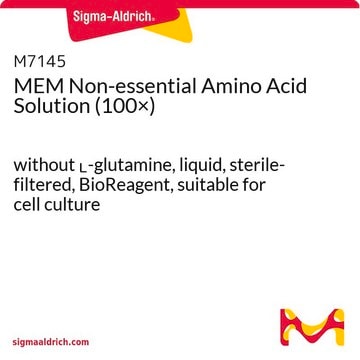In general, MEM typically contains 0.292 g/L L-Glutamine. A 200mM Glutamine solution is equivalent to 29.23 mg/mL. So it needs to be diluted around 100 times.
G7513
L-Glutamine solution
200 mM, solution, sterile-filtered, BioXtra, suitable for cell culture
Synonym(s):
Glavamin, Levoglutamide
About This Item
Recommended Products
sterility
sterile-filtered
Quality Level
300
400
product line
BioXtra
form
solution
concentration
200 mM
technique(s)
cell culture | mammalian: suitable
impurities
endotoxin, tested
shipped in
dry ice
storage temp.
−20°C
SMILES string
N[C@@H](CCC(N)=O)C(O)=O
InChI
1S/C5H10N2O3/c6-3(5(9)10)1-2-4(7)8/h3H,1-2,6H2,(H2,7,8)(H,9,10)/t3-/m0/s1
InChI key
ZDXPYRJPNDTMRX-VKHMYHEASA-N
Gene Information
rat ... Ggt1(116568)
Looking for similar products? Visit Product Comparison Guide
General description
Application
Preparation Note
Not finding the right product?
Try our Product Selector Tool.
Application
comparable product
recommended
related product
Storage Class Code
12 - Non Combustible Liquids
WGK
WGK 1
Flash Point(F)
Not applicable
Flash Point(C)
Not applicable
Choose from one of the most recent versions:
Already Own This Product?
Find documentation for the products that you have recently purchased in the Document Library.
Customers Also Viewed
Articles
Importance and uses of glutamine in hybridoma and mammalian cell culture
Importance and uses of glutamine in hybridoma and mammalian cell culture
Importance and uses of glutamine in hybridoma and mammalian cell culture
Importance and uses of glutamine in hybridoma and mammalian cell culture
Protocols
Learn how to perform cell migration assays in vitro using Millicell® hanging cell culture inserts and the suspension T-cell lines Jurkat and primary CD4+ cells. Monitor migration by flow cytometry and EZ-MTT assays.
Learn how to perform cell migration assays in vitro using Millicell® hanging cell culture inserts and the suspension T-cell lines Jurkat and primary CD4+ cells. Monitor migration by flow cytometry and EZ-MTT assays.
Learn how to perform cell migration assays in vitro using Millicell® hanging cell culture inserts and the suspension T-cell lines Jurkat and primary CD4+ cells. Monitor migration by flow cytometry and EZ-MTT assays.
Chromatograms
application for HPLCapplication for HPLC-
How much of Product G7513 should be used in cell culture media?
1 answer-
Helpful?
-
-
Is the molecular weight of L-Glutamine 146.14 or 146.15? The label information changed.
1 answer-
Based on a molecular formula of C5H10N2O3, the molecular weight to seven significant figures is 146.1456. Over the years, this value may have been reported in Sigma-Aldrich documentation or on labels as either 146.15 (by rounding up) or 146.14 (by truncation). The material itself has not changed.
Helpful?
-
-
Why is there a precipitate in the 200 mM L-glutamine solution, products G7513 and G2150, after thawing at room temperature?
1 answer-
L-Glutamine, 200 mM solution, tends to precipitate in solution when chilled. After thawing, it will be an opalescent solution. If allowed to settle, there can be some crystalline insolubles at the bottom of the bottle.The product should be warmed to 37°C for complete solubilization. To limit the number of times the product needs to be warmed to 37°C, the product can be divided into working aliquots which are stored at -20°C and used as needed. This will expose the product to the minimal amount of warming cycles.
Helpful?
-
-
What is the Department of Transportation shipping information for this product?
1 answer-
Transportation information can be found in Section 14 of the product's (M)SDS.To access the shipping information for this material, use the link on the product detail page for the product.
Helpful?
-
Active Filters
Our team of scientists has experience in all areas of research including Life Science, Material Science, Chemical Synthesis, Chromatography, Analytical and many others.
Contact Technical Service







